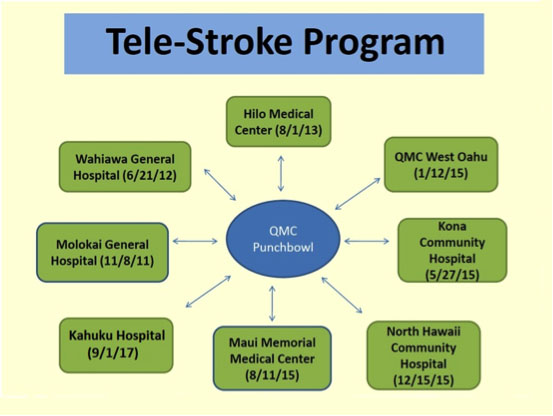Hawaii Tele-Stroke Program
Queen’s Medical Center Punchbowl
The Hawaiian Islands Regional Stroke Network Project
Project Funded by §321H-4 Neurotrauma Special Fund from January 2012 to May 2019
Funding was used to purchase telemedicine equipment for Queen’s Medical Center (QMC) Punchbowl (the “hub”) and eight statewide “spoke” sites (see diagram below). Emergency Department doctors and nurses, hospitalists, and administrators of the hub and spoke hospitals were educated on stroke care protocols and use of telemedicine technology.
QMC Punchbowl serves as the hub and has a neurologist on-call 24/7/365, available to the other 8 hospitals to evaluate stroke patients via the telemedicine equipment and make recommendations regarding whether to treat with Tissue Plasminogen Activator (tPA). tPA is the only drug approved by the Food and Drug Administration (1996) for acute treatment of ischemic stroke. tPA breaks up or dissolves blood clots, and for every 100 patients given tPA with 4.5 hours of onset of stroke symptoms, 28 patients will suffer less long-term disabilities than if they had not received the medication.
The program allows more hospitals to have the capacity to care for stroke patients, meaning that patients living in rural areas of the state can go to a closer hospital and receive treatment sooner, which is imperative to improving patients’ outcomes.
Tele-stroke Program Locations – Long Description
Project Goals
Goal 1
Improve statewide access to timely, expert stroke care evaluation and treatment with Tissue Plasminogen Activator (tPA) and educate providers on stroke evaluation and treatment.
Goal 2
Educate the public about stroke signs, symptoms, and what to do if someone may be experiencing a stroke. This includes:
- Signs and symptoms of stroke
- Stroke risk factors
- Importance of calling 9-1-1 immediately after the onset of stroke symptoms
- The availability of effective treatment with tPA
Demographic and Evaluative Data
Accomplishments as of the end of the contract period (May 2019):
- Initiated telestroke services at eight hospitals across the state;
- Completed 1251 telestroke consults and treated 424 patients with IV tPA by telemedicine, resulting in an estimated $19.1 million in cost savings;
- Completed multiple provider education initiatives to improve stroke treatment; and
- Completed multiple public education campaigns to increase recognition of stroke, including a school-based stroke education program that educated over 20,000 elementary students and their household members.
Primary Outcome Measures:
- Increased tPA utilization for all Hawaii stroke patients from 7.4% in 2011 to 17.9% in 2019.
- Improved the percent of patients whose ED arrival-to-treatment time was less than 60 minutes from a little over 30% in 2011 to over 90% in 2019.
The Hawaiian Islands Regional Stroke Network Project successfully sustained itself after the conclusion of the funding provided by the Department of Health by implementing a subscription-based hub-and-spoke model. The use of telemedicine continues to benefit patients in Hawaii, allowing them to receive treatment sooner and remain at their local hospital.
For additional information or questions regarding the Hawaiian Islands Regional Stroke Network Project, please contact [email protected]


